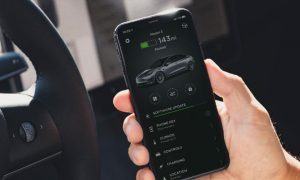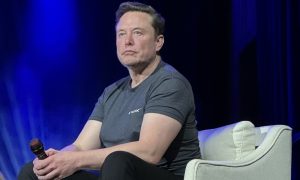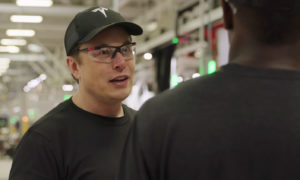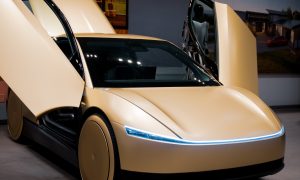

News
Solar vehicle fans rejoice: Aptera begins solar-cell production
Aptera has announced today that it has begun producing solar cells for its upcoming hyper-efficient EV.
A critical part of Aptera’s hyper-efficient vehicle design is the implementation of solar cells that cover the vehicle. Every upward-facing surface, from the roof to the interior dash, is equipped with solar cells, allowing maximum energy to be collected at any given time. And according to a video posted today, Aptera has begun producing solar parts as it hopes to start full vehicle production in the coming year.
Aptera’s youtube channel posted today that the company has begun producing the needed solar components that will be part of their upcoming vehicle.
The video also highlights some of the design goals Aptera set for its solar design. Longevity; capable of 15 years of use, durability; able to withstand impact and the environment, manufacturability; being able to produce the cells in large quantities, and efficiency; maintaining the brand’s dedication to efficient transportation.
With this announcement, they may only be capable of manufacturing roughly ten complete panels daily. Still, they have conquered the most significant design challenge of the vehicle and can move forward into vehicle production (hopefully) before the end of the year.
As the engineers in the video correctly point out, this is a significantly different approach to vehicle-mounted solar than ever before and is on a scale not attempted by legacy manufacturers on any production vehicle. The real test will come not in the lab but on the market when the car is released; will consumers recognize the benefits of vehicle-mounted solar? Only time will tell.
What do you think of the article? Do you have any comments, questions, or concerns? Shoot me an email at william@teslarati.com. You can also reach me on Twitter @WilliamWritin. If you have news tips, email us at tips@teslarati.com!
Investor's Corner
xAI targets $5 billion debt offering to fuel company goals
Elon Musk’s xAI is targeting a $5B debt raise, led by Morgan Stanley, to scale its artificial intelligence efforts.

xAI’s $5 billion debt offering, marketed by Morgan Stanley, underscores Elon Musk’s ambitious plans to expand the artificial intelligence venture. The xAI package comprises bonds and two loans, highlighting the company’s strategic push to fuel its artificial intelligence development.
Last week, Morgan Stanley began pitching a floating-rate term loan B at 97 cents on the dollar with a variable interest rate of 700 basis points over the SOFR benchmark, one source said. A second option offers a fixed-rate loan and bonds at 12%, with terms contingent on investor appetite. This “best efforts” transaction, where the debt size hinges on demand, reflects cautious lending in an uncertain economic climate.
According to Reuters sources, Morgan Stanley will not guarantee the issue volume or commit its own capital in the xAI deal, marking a shift from past commitments. The change in approach stems from lessons learned during Musk’s 2022 X acquisition when Morgan Stanley and six other banks held $13 billion in debt for over two years.
Morgan Stanley and the six other banks backing Musk’s X acquisition could only dispose of that debt earlier this year. They capitalized on X’s improved operating performance over the previous two quarters as traffic on the platform increased engagement around the U.S. presidential elections. This time, Morgan Stanley’s prudent strategy mitigates similar risks.
Beyond debt, xAI is in talks to raise $20 billion in equity, potentially valuing the company between $120 billion and $200 billion, sources said. In April, Musk hinted at a significant valuation adjustment for xAI, stating he was looking to put a “proper value” on xAI during an investor call.
As xAI pursues this $5 billion debt offering, its financial strategy positions it to lead the AI revolution, blending innovation with market opportunity.
News
SpaceX to debut new Dragon capsule in Axiom Space launch
Ax-4’s launch marks the debut of SpaceX’s latest Crew Dragon and pushes Axiom closer to building its own space station.

Axiom Space’s Ax-4 mission targets the International Space Station (ISS) with a new SpaceX Crew Dragon capsule.
The Axiom team will launch a new SpaceX Dragon capsule atop a Falcon 9 rocket from NASA’s Kennedy Space Center in Florida on Wednesday at 8:00 a.m. EDT (1200 GMT). The Ax-4 mission launch was initially set for Tuesday, June 10, but was delayed by one day due to expected high winds.
As Axiom Space’s fourth crewed mission to the ISS, Ax-4 marks the debut of an updated SpaceX Crew Dragon capsule. “This is the first flight for this Dragon capsule, and it’s carrying an international crew—a perfect debut. We’ve upgraded storage, propulsion components, and the seat lash design for improved reliability and reuse,” said William Gerstenmaier, SpaceX’s vice president of build and flight reliability.
Axiom Space is a Houston-based private space infrastructure company. It has been launching private astronauts to the ISS for research and training since 2022, building expertise for its future station. With NASA planning to decommission the ISS by 2030, Axiom has laid the groundwork for the Axiom Station, the world’s first commercial space station. The company has already begun construction on its ISS replacement.
The Ax-4 mission’s research, spanning biological, life, and material sciences and Earth observation, will support this ambitious goal. Contributions from 31 countries underscore the mission’s global scope. The four-person crew will launch from Launch Complex 39A, embarking on a 14-day mission to conduct approximately 60 scientific studies.
“The AX-4 crew represents the very best of international collaboration, dedication, and human potential. Over the past 10 months, these astronauts have trained with focus and determination, each of them exceeding the required thresholds to ensure mission safety, scientific rigor, and operational excellence,” said Allen Flynt, Axiom Space’s chief of mission services.
The Ax-4 mission highlights Axiom’s commitment to advancing commercial space exploration. By leveraging SpaceX’s Dragon capsule and conducting diverse scientific experiments, Axiom is paving the way for its Axiom Station. This mission not only strengthens international collaborations but also positions Axiom as a leader in the evolving landscape of private space infrastructure.
News
Tesla named official AV operator in Austin ahead of robotaxi launch
Tesla robotaxis could begin operating around Austin any day now, as echoed by an update to the city’s website.

Just as Tesla prepares to launch its own commercial robotaxi services in Austin, Texas this month, the company has now appeared on the state’s website as an official operator of autonomous vehicles (AVs).
As of Monday, Tesla has been listed as an AV operator on Austin’s official Department of Motor Vehicles (DMV) site, ahead of the company’s expected launch of the long-awaited service sometime this month. The news, which X user Tesla Yoda first spotted, precedes some reports suggesting the robotaxi service could launch in the coming days, and it comes as the city becomes an increasingly competitive stomping ground for the emerging technology.
Although Tesla has been included on the list, the website says that Tesla is still in the testing phase, alongside most of the other AV operators in the city. At this time, Alphabet-owned robotaxi company Waymo is the only operator listed as being in the deployment phase, while Hyundai-owned company Motional is listed as being in the mapping phase.
Tesla is set to initially deploy the service as a limited pilot program using the company’s existing Model Y vehicles, and it will start by testing them in the safest areas of the city within geo-mapped boundaries as extra safety precautions upon launch.
🚨 Elon says by end of June, the public should be ready to take a Robotaxi in Austin without an invitation
Initial launch will be small and riders will be picked by Tesla https://5023w.roads-uae.com/zEQOkXnE6s
— TESLARATI (@Teslarati) May 29, 2025
Below you can see the full list of AV operators on the Austin DMV website at the time of writing, including both the Alphabet-owned Waymo and the Amazon-run Zoox.
Current list of AV operators in Austin
- ADMT
- Phase: testing
- Parent company: VW
- AVRide
- Phase: testing
- Parent company: AVRide Inc
- Motional
- Phase: mapping
- Parent company: Hyundai
- Waymo
- Phase: deployment
- Parent company: Alphabet (Google)
- Tesla
- Phase: testing
- Parent company: Tesla
- Zoox
- Phase: testing
- Parent company: Amazon
READ MORE ON AUTONOMOUS VEHICLES: Elon Musk just revealed more about Tesla’s June Robotaxi launch
Tesla’s Austin robotaxi launch, Full Self-Driving, and other AV companies
The news follows a report from Bloomberg a few weeks ago saying that Tesla was considering a launch date of June 12 for the service, though the validity of that report is still unclear. Additionally, Tesla could still change its plans on a launch date, though the company’s inclusion on the Austin DMV AV operators list appears to be a good sign either way.
The company has also been running internal pilot programs for the robotaxi service in Austin and around the Bay Area, California, with around 300 test operators operating the vehicles in the Texas city since at least April. Last fall, CEO Elon Musk also said that employees had already been piloting a ride-hailing program around the Bay.
Tesla has long touted its Full Self-Driving (FSD) program as the solution to autonomy, with the system utilizing cameras and real-time driver footage to train its AI neural network on how to drive. By comparison, most other companies utilize cameras and radar systems together, while relying on geo-mapped systems to determine where the robotaxi can operate.
Waymo launched driverless ride-hailing services in Austin through a partnership with Uber, though the company has also been running paid robotaxi rides in various parts of California since last year through its Waymo One app. Other companies such as the Amazon-owned firm Zoox and the Hyundai-led company Motional are also preparing to deploy services in Austin and other U.S. cities.
Tesla’s ‘Project Alicorn’ and what it means for the Robotaxi platform
-

 News1 week ago
News1 week agoTesla to lose 64 Superchargers on New Jersey Turnpike in controversial decision
-

 News2 weeks ago
News2 weeks agoTesla gets major upgrade that Apple users will absolutely love
-

 News2 weeks ago
News2 weeks agoTesla teases new color while testing refreshed Model S, X
-

 Elon Musk2 weeks ago
Elon Musk2 weeks agoTesla investors demand 40-hour workweek from Elon Musk
-

 Elon Musk7 days ago
Elon Musk7 days agoElon Musk explains Tesla’s domestic battery strategy
-

 News2 weeks ago
News2 weeks agoTesla Cybertrucks join Jalisco’s police fleet ahead of FIFA World Cup
-

 News2 weeks ago
News2 weeks agoTesla rolls out new crucial safety feature aimed at saving children
-

 Elon Musk2 weeks ago
Elon Musk2 weeks agoTesla lands on date for Robotaxi launch in Austin: report





















